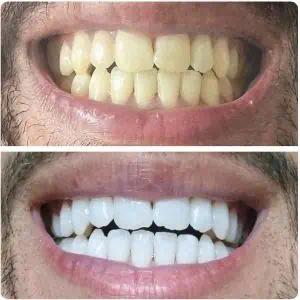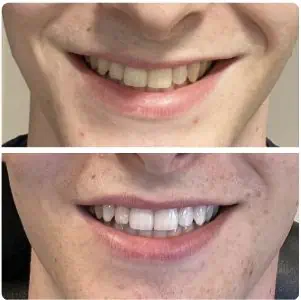If you paid for a shiny new smile but now it’s yellowing and becoming stained, then you may be wondering, can you whiten veneers? Whether you’re about to get veneers, they’re recently new, or you’ve had them for a while, we want to make sure you have all the information you need before you attempt to whiten your teeth.
In this article, we’ll answer some of the common questions surrounding whitening veneers, including:
- What are veneers?
- Do veneers stain, and how can you prevent staining?
- Can you whiten veneers?
- Is it safe to use teeth whitening treatments on them?
- What are ways I can whiten veneers?
- What are some tips for cleaning veneers?
Keep reading to gain clarity on teeth whitening for crowns and veneers. But first, let’s start with discussing what veneers are and the different types.
Porcelain veneers can be whitened like natural teeth. You can’t whiten composite bonding, though, but there are several things you can do to improve the aesthetics, which we’ll discuss in this article.
Consult a dentist to determine which procedure is necessary for your specific case. If a teeth whitening kit can be used to whiten your veneers, we recommend having a look at Smile White.
In This Article
What are veneers?

If you want to improve your smile, dental veneers are a simple option. They are thin plastic or porcelain coverings that are placed over the front (visible) part of the tooth. They look like natural teeth except they make your smile look better. This is because they are used to help correct a wide range of dental issues, such as:
- Teeth that are stained and can’t be whitened by bleaching
- Chipped or worn teeth
- Crooked or misshapen teeth
- Uneven spaces or a large gap between the upper front teeth
Dental veneers are made from either porcelain or composite resin material. Let’s discuss the differences in slightly more detail to understand them better.
Porcelain veneers
Porcelain veneers are thin shells made from porcelain that are placed over the tooth to give you an even, bright smile. They are made in a dental lab by a skilled technician before your dentist can apply them to your teeth. Generally, a layer of enamel will need to be shaved down first to make space for this type of veneer, a process that is irreversible.
Composite veneers
A composite resin veneer is made from a tooth-coloured filling material that is applied directly to the tooth, built up and shaped and then hardened with an LED light. With this type of veneer, it isn’t always necessary to shave away part of the enamel.
Since the composite resin is applied directly to your teeth, this is the quicker treatment because you don’t need to wait for the veneers to be made in a lab first.
Can veneers stain?
Yes. Composite veneers stain easily due to fact that the resin material used to make them is very porous. On the other hand, with veneers made of porcelain, it’s a slightly different story.
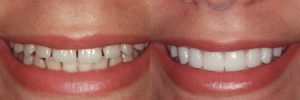
Do porcelain veneers stain?
Porcelain veneers are known for their durability and stain-resistant qualities. They are finished with a glaze which is resistant to stains, but if this wears away the porcelain is liable to stain.
Can veneers be whitened?
Yes, it is possible to whiten porcelain veneers, but not composite resin veneers. Even though you can’t whiten composite bonding, that doesn’t mean you can’t improve the way they look.
Professional dental cleanings can help remove surface stains. However, if your veneers are significantly discoloured, your dentist may recommend replacing them.
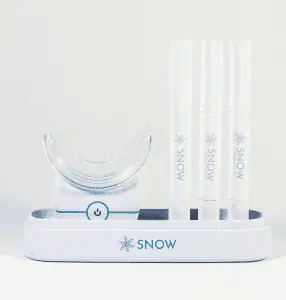
- Our #1 Teeth Whitening Kit
- Snow offers lasting results in just 9 minutes a day and satisfaction guaranteed or your money back.
- Fast Results: Noticeably whiter teeth after just one use, with full results in 21 days.
- Safe for Sensitive Teeth: Designed to be pain-free, even for those with sensitivity.
- Easy to Use: A convenient and straightforward application process.
- Celebrity Endorsed: Trusted and used by celebrities for a brighter smile.
Is it safe to use teeth whitening products on porcelain veneers?
Don’t worry about whitening treatments harming your crowns or porcelain veneers. They are made of extremely strong materials and won’t be affected by the bleach in the tooth whitening treatments.
5 ways to whiten porcelain veneers:
There are several different ways for teeth whitening veneers, some of them include:
1. Brush your teeth after eating staining foods
Fortunately, veneers don’t stain as easily as regular teeth, so you won’t have to monitor them as often. However, if you’re a coffee-lover, brush your teeth after your morning or mid-afternoon cup to keep your veneers from getting stained.
Avoid acidic food and drink like lemon, soda, and coffee. Since they are acidic and sugary, this will cause more noticeable stains, break down the porcelain, and increase the likelihood of gum disease.
2. Use polishing toothpaste
There are toothpaste brands that are specifically designed to remove buildup on veneers and minor stains. While some are available online, your dentist may recommend prescription-strength fluoride to keep your veneers at their whitest.
3. Get them professionally cleaned
As you may already know, plaque can build up on your natural teeth due to food particles and decaying sugar but it can also damage the surface of your veneers making them look dull. To avoid this, make sure you schedule dental cleanings with your dentist or hygienist twice a year to ensure the longevity of your veneers so they remain as white as possible.
4. Teeth whitening kits
Teeth whitening kits work on both your natural teeth and veneers!
Make sure to always follow the instructions completely for a teeth-whitening system and talk to your dentist before attempting to whiten your teeth at home.
5. Professional in-office whitening treatments
The fastest way to whiten your porcelain veneers is by getting them professionally whitened. Your dentist will also be able to recommend the best ways to whiten your veneers to match your natural teeth. Using home whitening kits may not get you the results you want when compared with professional results.
6. Cosmetic dentistry
At about the six or seven-year mark, you’ll have to replace your veneers if you want your smile to look as bright as it did originally.
You can also try out alternative teeth whitening options such as using lemons or banana peels; they might not work as well as more traditional whitening treatments but feel free to have a go!
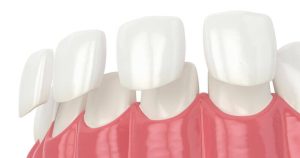
How to avoid staining veneers
1. Maintain good brushing habits
Veneers need to be brushed just like natural teeth. Brushing with flossing helps to remove surface stains and keep the underlying tooth healthy.
Veneers only cover the front of your tooth, leaving the sides, and back of the tooth exposed. Brushing and flossing your teeth twice a day is the easiest way to prevent exposed areas from decaying.
2. Use a gentle toothpaste
Many whitening kinds of toothpaste contain baking soda, which is safe for natural teeth but too abrasive for veneers.
Look for gentle kinds of toothpaste or products designed for use on veneers. Your dentist can make product recommendations if you’re not sure what’s best for you.
3. Don’t smoke
Tobacco doesn’t cause veneers to stain, but smoking can lead to significant yellowing of the underlying tooth. This can then lead to patchy discolouration of your smile. Tobacco may also affect the integrity of the bonds holding your veneers in place, so you may need to get them replaced sooner than a non-smoker would.
4. Go to your dentist regularly
Just as you brush and floss daily, you should see your dentist regularly as part of a healthy smile routine. Getting dental examinations and routine scale and polish appointments can help prevent cavities and treat decay and gum disease in its early stages.
Maintaining your oral health with the help of your dentist will maximise the longevity of your veneers and keep your smile looking beautiful.
Tips for cleaning your veneers
1. Switch to a soft bristle toothbrush
You may think a hard bristle toothbrush is the best way to clean your teeth and gums, but many hard bristle brushes are too rough. They may even cause the gums to recede over time, which can expose your natural teeth to decay and cause discolouration.
Stick with a soft bristle toothbrush instead. Soft bristles get your teeth clean without the risk of wearing down your veneers and gums.
2. Avoid toothpaste with baking soda
Don’t try whitening veneers with baking soda. While baking soda is a great ingredient to clean natural teeth, it’s too abrasive for porcelain veneers and may cause them to wear down earlier and become discoloured.
Conclusion
Dental veneers can really make a difference to how your smile looks, but it’s good to know how to keep it looking bright and shiny. Veneers work by covering up your natural teeth to correct dental issues such as chipped or cracked teeth, gaps, discolouration and even make mildly crooked or misshapen teeth appear straighter.
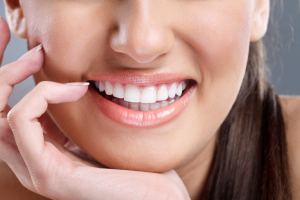
There are two main types of veneers, composite resin and porcelain, and each material reacts to staining and whitening differently.
Porcelain veneers are less liable to stain and are much more durable. However, once their top glaze wears off, they might stain, so make sure you take care of them and keep them clean.
Fortunately, it is possible to whiten porcelain veneers, and the bleaching agents will not harm the porcelain material. Just make sure you read the instructions before using any home whitening ingredients, or consult your dentist for professional whitening treatments.
Composite veneers can stain because of the porous nature of the resin, so it’s best to avoid consuming highly pigmented food and drink and to get your teeth polished more regularly by a dentist. Now that you know how to whiten veneers, try out some tips above to brighten your smile and prevent staining.
If you are still uncertain about attempting to whiten veneers on your own, consult your dentist for their recommendations first.
Daxon Dentistry. How to whiten porcelain veneers. Consulted 28th April 2022.
Oral Health Foundation. Veneers. Consulted 28th April 2022.
Dentistry.co.uk. Porcelain veneers: the pros and cons for your patients. Consulted 28th April 2022.





